Family : Echeneidae

Text © Giuseppe Mazza

English translation by Mario Beltramini
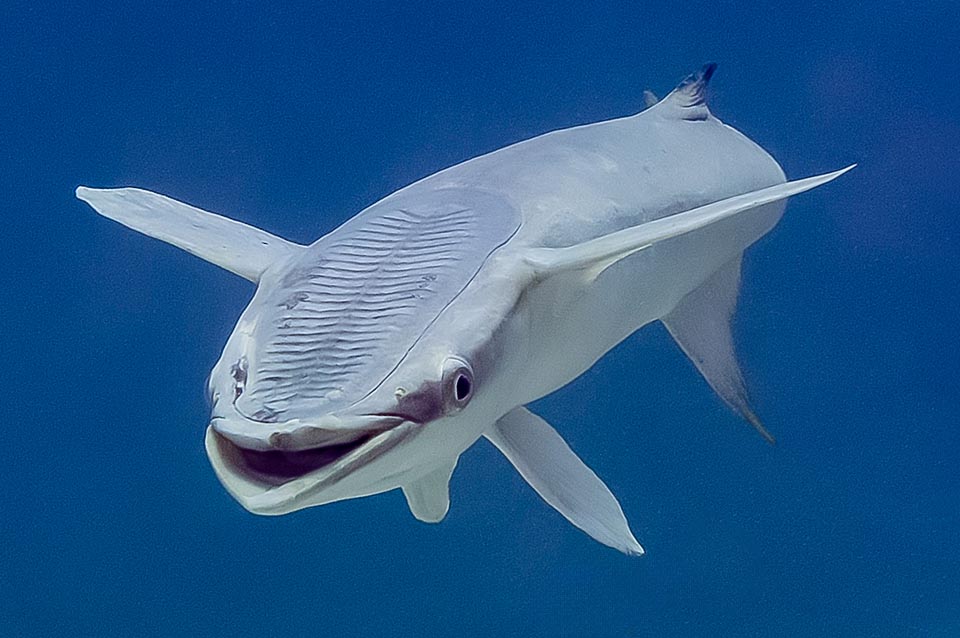
Present in all world tropical and temperate seas, Echeneis naucrates is the biggest extant remora that here seems to smile due to its shorter upper jaw © Allison & Carlos Estape
The Live sharksucker (Echeneis naucrates Linnaeus, 1758), belongs to the class of the Actinopterygii, the ray-finned fishes, to the order of the Carangiformes and to the family of the Echeneidae, assigned to the remoras, with 3 genera and 8 species.
They are all animals with slender and tapered bodies, 17 to 100 cm long, characterized by a sucking disc located on the head to attach and be transported by fishes, turtles, marine mammals and even by ships.
The genus Echeneis in fact gets its origin from the Greek “echein”, to keep, and “naus”, ship and the specific term naucrates, again indicates, always in Greek, “naus” and “krates”, master, because after old legends, attaching, they could steer them, slowing down their run and even stopping them.
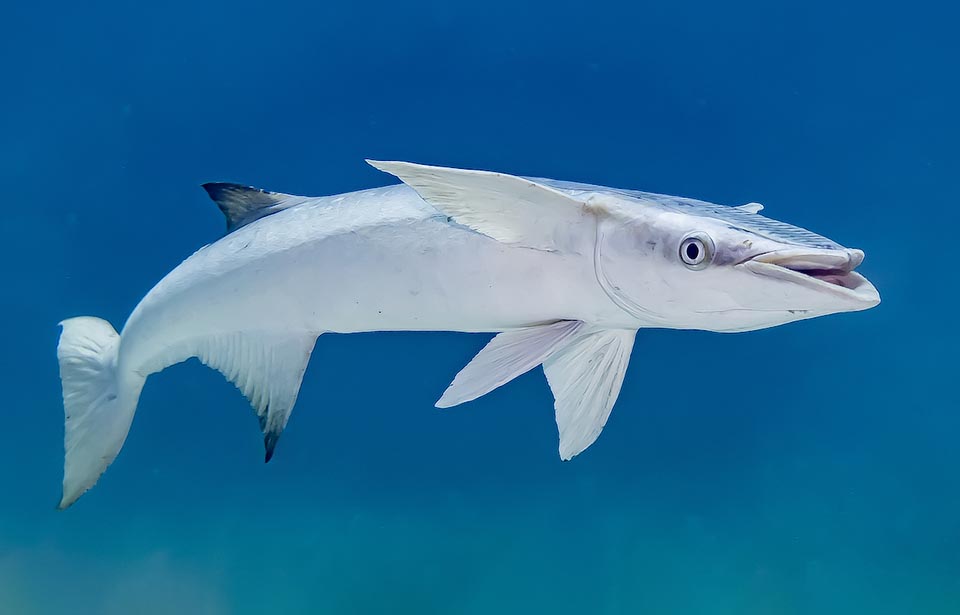
Indeed, the dense and thin dentition of the latter, together with the teeth on the palate, serves to hold the plankton that flows to the mouth ajar, while the host moves © Allison & Carlos Estape
Zoogeography
Echeneis naucrates is the most common remora, present in the warm and temperate waters of all the world, except the eastern Pacific coasts.
We find it in western Atlantic from Massachusetts and the Gulf of Mexico up to Argentina and is very abundant in the Caribbean.
In the eastern Atlantic it is present from the southern Açores up to St. Helena island and along the African coast up to South Africa.
In the Indo-Pacific it goes up close to Madagascar and adjacent islands up to East Africa, the Seychelles and the Red Sea.
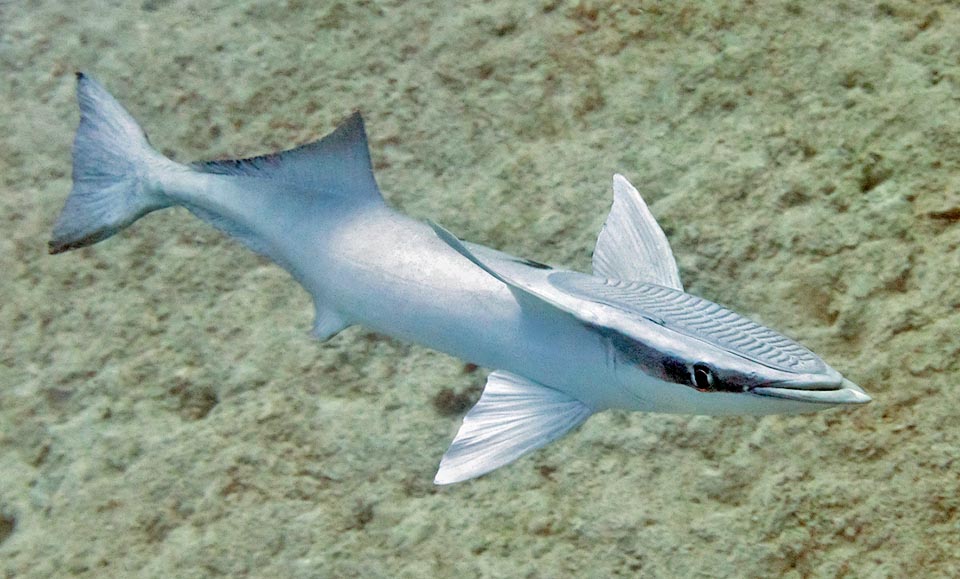
More, unlike most remoras, Echeneis naucrates swims also independently, preying upon fishes, squids and crabs with its lower jaw long teeth © Allison & Carlos Estape
Attaching. to the ships crossing Suez Canal, it has also entered the Mediterranean increasing the large crowd of the so-called lessepsian fishes, from the name of Ferdinand de Lesseps, promoter and executor of the Canal.
Then the Live sharkssucker is found in India, Indonesia, Philippines, Japan, Australia and, finally, in the Hawaii Islands, in Easter Island and in the Galapagos that mark its eastern limit in the Pacific.
Ecology-Habitat
Unlike most remoras, Echeneis naucrates often goes swimming freely in shallow waters, without the need to attach to a host.
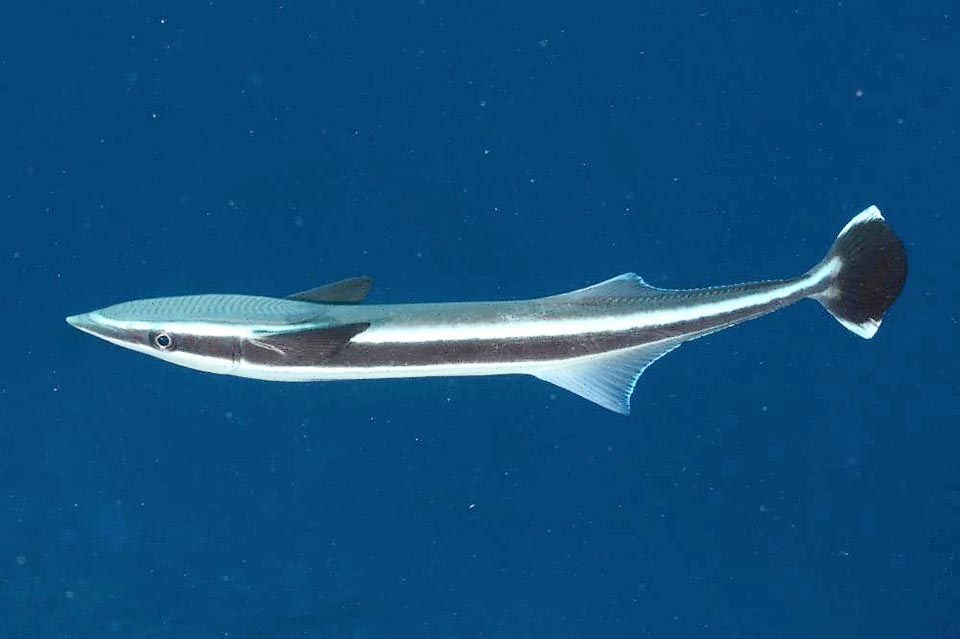
Livery varies with the size of the animal. especially in the young, we note a dark band that runs through the fish crossing the eye © Graham Edgar, Reef Life Survey
It is found along the coasts, close to the madreporic formations and occasionally in the estuaries, up to about 15 m of depth, but it may reach even 85 m and more, if attached to sharks or manta rays moving downwards.
Morphophysiology
With its length of 1 m, Echeneis naucrates is the biggest remora of the family. There is no swim bladder and the body is covered by tiny cycloid scales.
The livery varies depending on the size of the animal. Especially in the juveniles, we note a dark horizontal band on the sides that, starting from the caudal fin, crosses the eye and reaches the tip of the lower jaw, highlighted, above and below, by a white band.
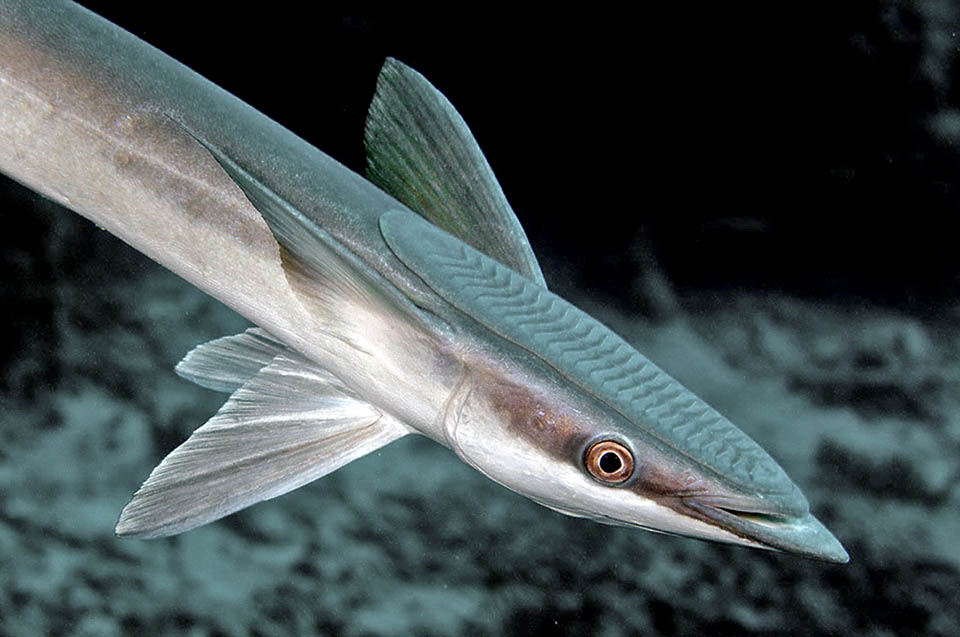
In this species the adhesive sucker on the head reaches the middle of the pectoral fins. Inside it are 18-28 couples of mobile laminae to pump out the water © Paddy Ryan
Then the contrast fades and grey often dominates.
The youngest have yellow orange hues and after some photos and the images present on some books, it seems that the yellow is present also in the adults circulating in the Red Sea.
There are two dorsal fins and the first fin, as in all remoras, has transformed into a rounded oblong sucker rounded at the apices.
In Echeneis naucrates it reaches the middle of the pectoral fins and has inside 18-28 couples of inclined mobile laminae, towards the tail, like the slats of a shutter.
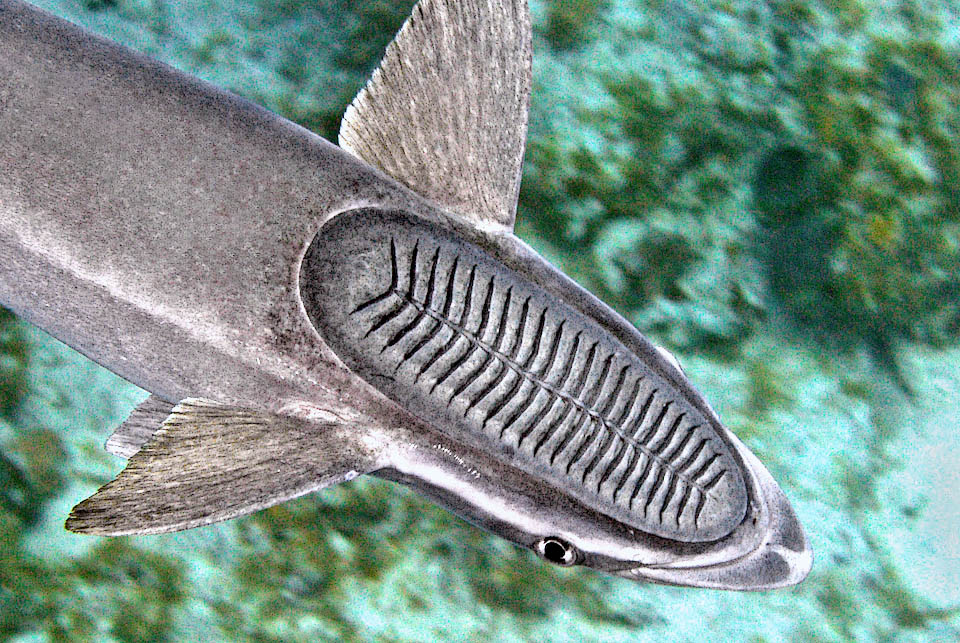
Thus a depression creates that keeps hold thanks to a valve prevents water from re-entering until when the fish doesn’t decide to open it to detach from the host © Allison & Carlos Estape
When the remora settles on the host, these, moving, pump out the water and the depression that forms and keeps the fish attached is ensured by a valve, with a flap lock, located near the first couple of lamellae.
All these are serrated on the bottom and when the host accelerates they straighten up increasing the grip.
This is well known by the local fishermen that use the poor Echeneis naucrates for catching the turtles that are resting on the seabeds.
They throw into water the remora tied by the tail to a sturdy rope, and if this hooks it by instinct hoping to go far, pulling the rope the lamellae straighten up and the turtle with the remora are easily hoisted on board.
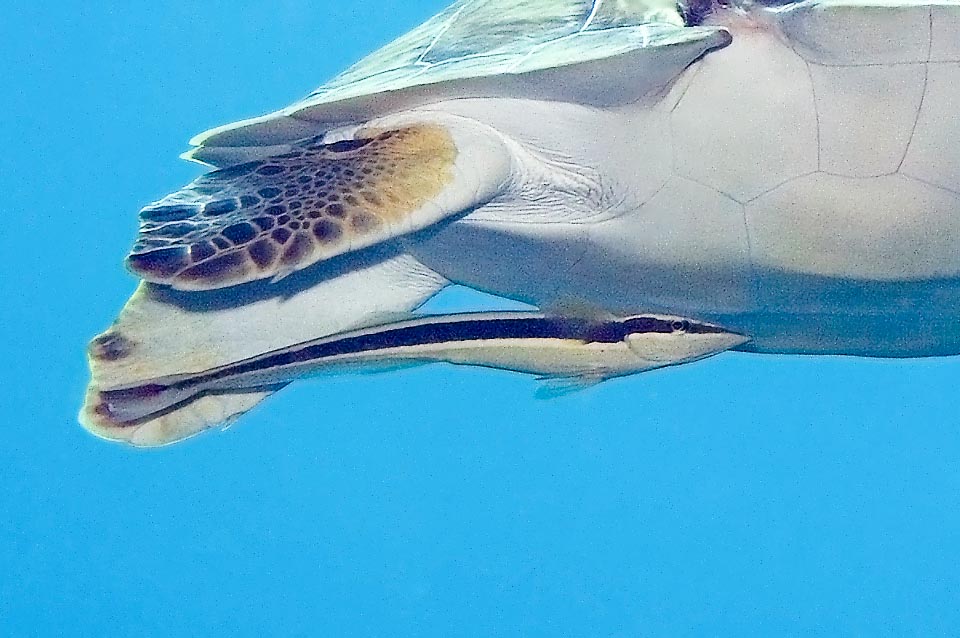
Echeneis naucrates often attaches to the turtles that often cleans from parasites but also to the submerged hulls of the ships and marine mammals like whales and dolphins © Allison & Carlos Estape
To detach the sucker it is then enough to push the fish forward, while at sea, when the remora wants to abandon the host, just has to open the valve by lifting the flap and the water, entering, eliminates the depression and consequently the grip.
The second dorsal fin of Echeneis naucrates has about 32-42 soft rays and the anal, symmetrical, 29-41.
The pectoral ones, placed high on the body close to the operculum, are pointed with 22-23 rays, and the big pelvic are quite similar.
The head is flat with a triangular rostrum and jaws with reduced contact surface. The lower, prominent, has big teeth of various sizes for catching the preys.
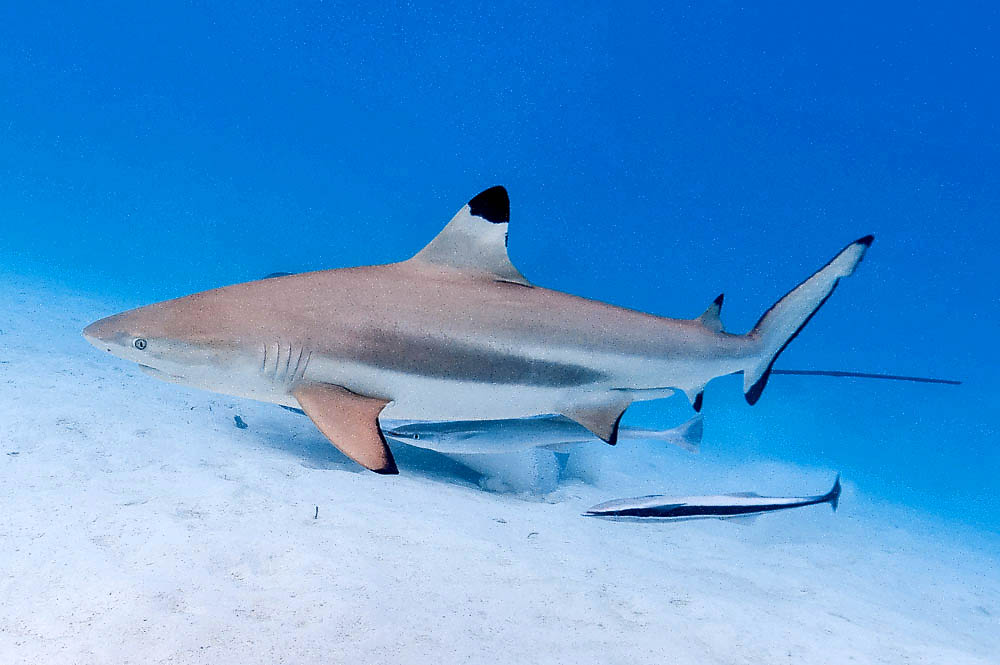
Among its choice guests stand the sharks who disperse during their attacks fragments of food. Here they survey a Carcharhinus melanopterus with a ray fish close © François Libert
Conversely, the upper one has 3-4 rows of small sharp and edgy teeth reaching 2-3 mm in the adults. Then there are more on the palate and when the remora moves mouth open attached to the host filter the water bound to the gills holding various planktonic organisms like larvae and eggs.
Ethology-Reproductive Biology
When hunting alone, Echeneis naucrates feeds on fishes, squids and small crabs. If it is carried by the host, besides the plankton, that is its main dish, takes advantage of any possible leftover food and fres it from the small parasitic crustaceans.
Also the juveniles often clean from the skin parasites the parrotfishes in the “cleaning stations” and if they find one of them of a big size, like for instance Sparisoma viride they hook it and begin immediately, filtering the plankton, their career.
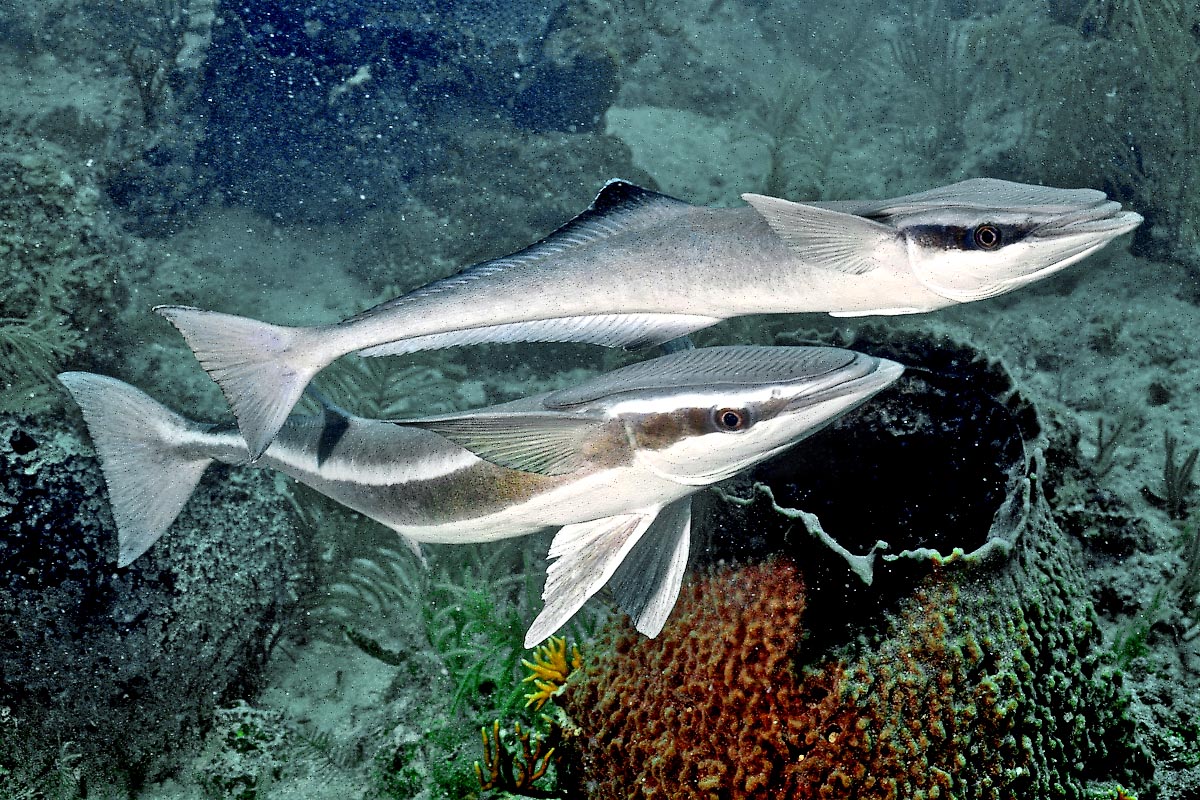
For reproduction couples form and the fecundated eggs are entrusted to the currents. Also larvae are pelagic and after about one year the young measure 3 cm © Allison & Carlos Estape
The reproduction of the Live sharksucker takes place in spring-summer in the warm waters and in autumn in the Mediterranean.
The fecundation occurs in couples with big and spherical pelagic eggs entrusted to the currents.
Also the larvae are planktonic. Upon hatching they measure 0,47-0,75 cm and when they have consumed the yolk sac they eat planktonic microorganisms. Then the juveniles take about one year before reaching the length of 3 cm.
At that time they are capable of attaching to a host and mature sexually around the 3-5 years of age.
The resilience is mediocre, with a minimal time for doubling the populations of 1,4-4,4 years, but the fishing vulnerability is very high, marking 66 on a scale of 100 because it often runs into the nets.
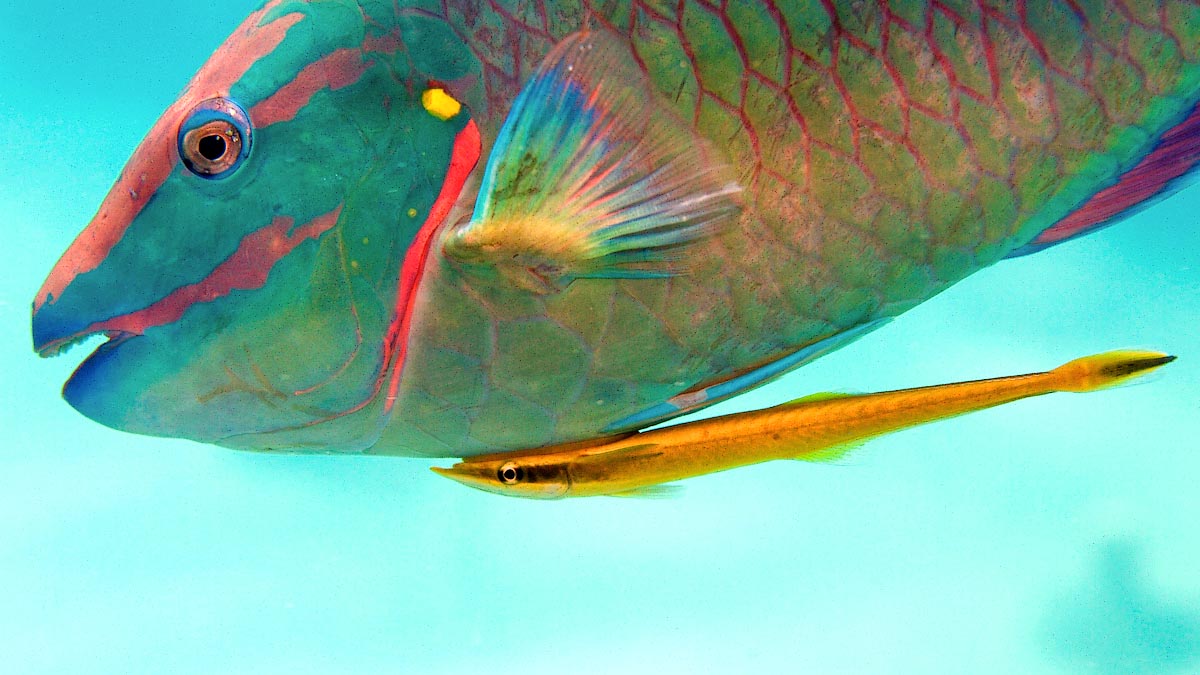
They frequent the cleaning stations freeing fishes from the skin parasites and begin their career as guests attaching to parrotfishes, like this Sparisoma viride © Allison & Carlos Estape
The Live sharksucker thus ends on the local markets even if its flesh may cause hives, vomit and diarrhoea.
However, considering its planetary diffusion, Echeneis naucrates appears since 2012 as “LC, Least Concern”, in the IUCN Red List of the endangered species.
Synonyms
Leptecheneis naucrates (Linnaeus, 1758); Echeneis lunata Bancroft, 1831; Echeneis vittata Rüppell, 1838; Echeneis fasciata Gronow, 1854; Echeneis fusca Gronow, 1854; Echeneis guaican Poey, 1860; Echeneis metallica Poey, 1860; Leptecheneis flaviventris Seale, 1906.
→ For general information about FISH please click here.
→ For general information about BONY FISH please click here
→ For general information about CARTILAGINOUS FISH please click here.
→ To appreciate the BIODIVERSITY of BONY FISH please click here.
→ To appreciate the BIODIVERSITY of CARTILAGINOUS FISH please click here.
